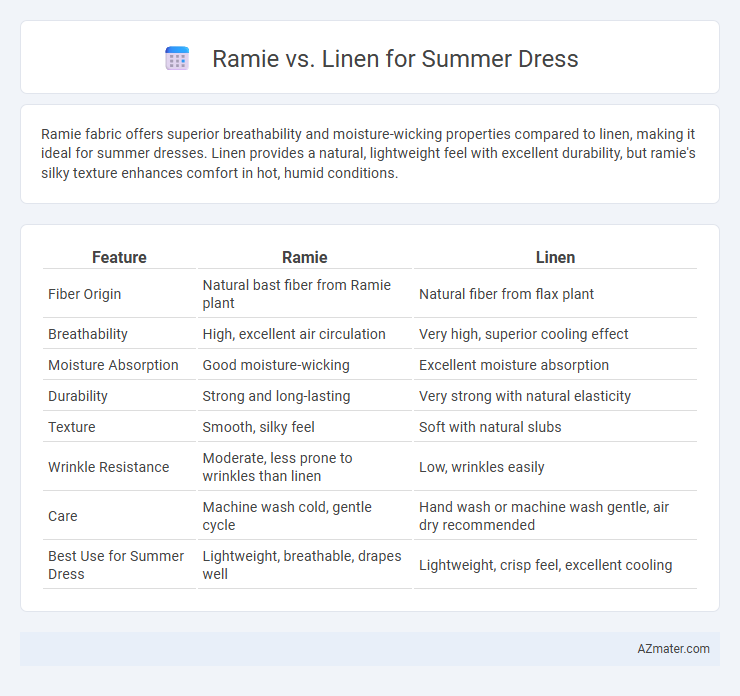Ramie fabric offers superior breathability and moisture-wicking properties compared to linen, making it ideal for summer dresses. Linen provides a natural, lightweight feel with excellent durability, but ramie's silky texture enhances comfort in hot, humid conditions.
Table of Comparison
| Feature | Ramie | Linen |
|---|---|---|
| Fiber Origin | Natural bast fiber from Ramie plant | Natural fiber from flax plant |
| Breathability | High, excellent air circulation | Very high, superior cooling effect |
| Moisture Absorption | Good moisture-wicking | Excellent moisture absorption |
| Durability | Strong and long-lasting | Very strong with natural elasticity |
| Texture | Smooth, silky feel | Soft with natural slubs |
| Wrinkle Resistance | Moderate, less prone to wrinkles than linen | Low, wrinkles easily |
| Care | Machine wash cold, gentle cycle | Hand wash or machine wash gentle, air dry recommended |
| Best Use for Summer Dress | Lightweight, breathable, drapes well | Lightweight, crisp feel, excellent cooling |
Introduction to Ramie and Linen
Ramie is a natural fiber derived from the stalks of the Chinese nettle plant, renowned for its strength, breathability, and ability to hold shape, making it an excellent choice for summer dresses. Linen, obtained from flax fibers, is prized for its lightweight, moisture-wicking properties, and crisp texture that enhances comfort in hot weather. Both fabrics offer superior cooling effects, but ramie's silky luster contrasts with linen's characteristic textured weave.
Fiber Origins and Cultivation
Ramie fiber, derived from the stalks of the Chinese nettle plant (Boehmeria nivea), thrives in warm, humid climates and requires minimal pesticides, making it an eco-friendly choice for summer dresses. Linen comes from flax plants (Linum usitatissimum), cultivated in cooler regions such as Europe and Canada, where flax is grown in well-drained soil with moderate rainfall. The natural strength and moisture-wicking properties of both fibers result from their unique plant origins and cultivation methods, influencing their breathability and durability in summer wear.
Breathability and Comfort in Hot Weather
Ramie and linen both offer excellent breathability for summer dresses, with ramie fibers moisture-wicking and allowing increased airflow, enhancing comfort in hot weather. Linen's natural texture provides superior cooling properties due to its high absorbency and quick-drying ability, making it ideal for maintaining a fresh feel throughout the day. Ramie tends to have a slightly smoother finish, which can reduce skin irritation, while linen's crispness gives a lightweight, airy sensation favored in tropical climates.
Moisture-Wicking Properties
Ramie fabric exhibits excellent moisture-wicking properties, drawing sweat away from the skin to keep the wearer cool and dry during hot summer days. Linen also offers strong breathability and moisture absorption, promoting airflow that enhances comfort in humid conditions. Choosing ramie or linen for a summer dress ensures effective moisture management, with ramie slightly outperforming linen in quicker drying times due to its fiber structure.
Durability and Strength Comparison
Ramie fabric exhibits exceptional durability and tensile strength due to its long bast fibers, making it highly resistant to wear and tear compared to linen. While linen offers a comfortable, breathable texture ideal for summer dresses, ramie provides superior resilience, maintaining fabric integrity under frequent use and washing. This durable nature of ramie ensures longevity, making it a preferred choice for summer garments requiring both strength and lightweight comfort.
Texture and Aesthetic Appeal
Ramie fabric offers a smooth, lustrous texture with a natural sheen that enhances the visual appeal of summer dresses, providing a crisp and elegant look. Linen features a more textured, slightly rough surface with visible weave variations, giving dresses a relaxed, breathable, and rustic charm ideal for casual summer wear. Both fabrics excel in breathability and cooling effects, but ramie's finer texture contributes to a polished aesthetic, while linen emphasizes natural, laid-back style.
Environmental Impact and Sustainability
Ramie and linen are both eco-friendly fibers with low environmental impact, but ramie requires fewer pesticides and consumes less water during cultivation compared to flax used for linen. Linen biodegrades quickly and has a longer lifespan, reducing waste, while ramie's production involves chemical processing that can affect sustainability if not managed properly. Choosing between ramie and linen for summer dresses depends on prioritizing either water-efficient growth or natural biodegradability and durability.
Ease of Care and Maintenance
Ramie fabric offers superior wrinkle resistance compared to linen, making it easier to maintain for summer dresses without frequent ironing. Linen tends to wrinkle more easily but can be machine washed gently, whereas ramie requires delicate care to preserve its fibers and prevent shrinkage. Both fabrics are breathable and ideal for warm weather, yet ramie's durability allows for longer-lasting wear with proper maintenance.
Price and Accessibility
Ramie fabric is generally more affordable than linen, making it a cost-effective choice for summer dresses without compromising on breathability and comfort. Linen tends to be pricier due to its labor-intensive production and limited growing regions, which can affect its accessibility in some markets. Both fabrics are widely available, but ramie's lower price point often makes it more accessible for budget-conscious consumers seeking lightweight summer attire.
Which Fabric Wins for Summer Dresses?
Ramie offers superior moisture-wicking and breathability compared to linen, making it ideal for hot, humid summer days. Linen is prized for its natural texture and durability but tends to wrinkle more easily and can feel rougher on sensitive skin. For lightweight, cool, and comfortable summer dresses, ramie edges out linen due to its softness and excellent moisture management.

Infographic: Ramie vs Linen for Summer Dress
 azmater.com
azmater.com